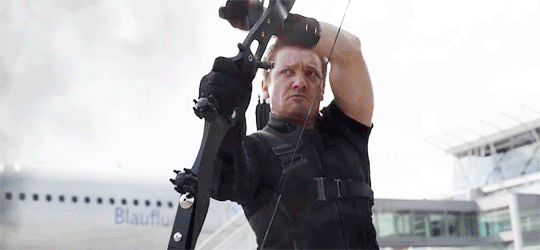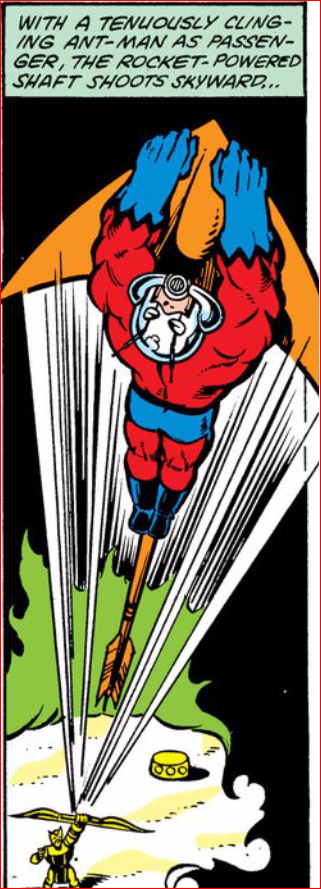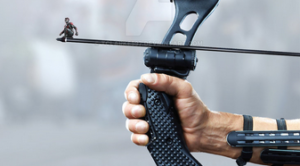Say you’re a miniature super-hero like Ant-Man, there’s a Civil War going on, and you’ve got to get to your target super-fast. Let’s also say your super-hero pal just happens to be a guy with a bow and arrows.
You see where we’re going with this?
When the second trailer for Captain America: Civil War was released in March, a portion of Avengers fans lost their minds a little. In the trailer, Hawkeye is seen to fire an arrow which bursts on its way to its target, and on one of those flying pieces is Ant-Man, hitching a ride up to Iron Man, presumably to do things for #TeamCap.
The clip was a throwback to Marvel’s Avengers #223 from 1982 – “Of Robin Hoods and Roustabouts” – where Ant-Man helped Hawkeye capture the villain Taskmaster at the Carson Carnival of Traveling Wonders. As part of their plan on catching a falling clown bomb, Ant-Man rode one of Hawkeye’s arrows up to the target and, at the last minute, deactivated the bomb (you can find the issue in back-issue bins at your local comic shop, or digitally at Comixology).
And Avengers history was made.
As that history looks to be re-made in movie form in Captain America: Civil War (and as a toy from Hot Toys), we figured it was time to take a look at the science of riding an arrow. Is it a good way to travel, if you’re the size of an ant, man?
Right out of the gate, we made some assumptions:
- Hawkeye’s bow was the Hoyt Gamemaster II, which he used in Avengers: Age of Ultron. This may be changed for Civil War, but it shouldn’t affect the outcome much, if at all. The Gamemaster II is a recursive bow with a range of draw weights, from 35 to 65 lbs (the draw weight is how much force is needed to pull the bowstring back). We assumed a 65 pound pull, because that would allow for a faster velocity, and look, when you’re fighting Iron Man, you want to shoot Ant-Man to where he is, not where he was, so you need your arrow to move fast.
- Hawkeye’s arrow – we chose a standard 350 grain, 30” arrow. Again, this may not be entirely correct, but it’s a comfortable choice. “Grains” by the way are unit of weight, and 1 grain = 1/7000th of a pound, so carrying out that conversion to metric – a 350 grain arrow has a mass of 22.7 grams, or 0.0227 kg. We’re going to work this up for a regular arrow – even though his has an explosive tip – we’ll stick with our 0.0227 kg. The 30” of the arrow is 0.61 m.
- Hawkeye’s pull distance is two feet. In other words, he pulls the bowstring back two feet to fire the arrow with his buddy on it.
- Drag is negligible for the shot – okay, this is not entirely true, but it’s a short distance between Hawkeye and Iron Man (we’re calling it about 50 m), and it’s a straight shot, rather than a parabola.
- Ant-Man effectively has no mass at the launch. Go with us here…indulge us.
- Oh, and people can shrink as small as insects.
 What we’re trying to find out is what it would feel like to ride that arrow – or basically, what Hawkeye’s arrow experiences at launch.
What we’re trying to find out is what it would feel like to ride that arrow – or basically, what Hawkeye’s arrow experiences at launch.
First up, let’s get our velocity when the arrow first flies.
The way to do this is the utilize the relationship between work and energy. When Hawkeye pulls the bowstring back, he’s doing work on it – applying a force over a distance. The force and distance are both in the same direction (pulling back towards his shoulder), so to calculate the work, we multiply the force – 65 lbs, by the distance it was applied, 2 feet.
Work = 65 lbs x 2 feet = 130 foot-pounds
Foot-pounds are a unit of work or energy (work and energy share the same units), albeit a non-SI unit, so we need to convert 130 foot-pounds to joules, the SI unit of work and energy. 1 foot pound = 1.35581795 joules, so 130 foot-pounds = 176.256 joules.
This is where the relationship between the work done by Hawkeye and the energy of the arrow start to pay off for us. Hawkeye did work on the arrow by pulling it back. If he were to stop there, that work would be equal to the elastic potential energy of the string that was pulled back and will ultimately push the arrow away from the bow. When Hawkeye releases the string, the elastic potential energy is changed into kinetic energy as the string (with the arrow in front of it) moves rapidly to return to its resting place. The string returns to rest, giving virtually all of its kinetic energy to the arrow to propel it forward. In other words:
WorkHawkeye = Elastic potential energybowstring = Kinetic Energybowstring = Kinetic Energyarrow
The formula for kinetic energy is:
Kinetic Energy = (½)(mass)(velocity)2
Since we’re assuming the string gives 100% of its kinetic energy to the arrow, we can put the mass of the arrow in our formula. And of course, the kinetic energy is equal to the work done by Hawkeye – 176.256 joules, so:
176.256 J = ½ (0.027 kg)v2
Solving for velocity, we get:
velocity = 124.6 meters/second
Converting to miles per hour: the arrow leaves the bow at 278.7 miles per hour.
Remember, we’re assuming that Ant-Man has no mass, so we’re effectively doing these calculations for the arrow alone – which works for our purposes. You’ll see.
How long does the arrow take to leave the bow, and what’s its acceleration as it leaves? We can knock those two values out with one and a half stones:
First: acceleration. Newton’s second law will help us figure that out:
Force = (mass)(acceleration), so…rearranging:
Acceleration = force/mass
Force = 65 lbs, but let’s change that to the SI unit of force – Newtons. 65 lbs = 289.134 N.
Mass = mass of the arrow, 0.0227 kg.
a = 289.134 N/0.0227 kg
a = 12,737.18 meters/second2
In terms of g-forces, that’s roughly 1,299.7 g. G-forces are the accelerations that make you feel heavier and can be felt either horizontally or vertically, depending on your situation. On earth’s surface, we live at 1 g. At 2 g you’d feel 2 times heavier, 3 times at 3 g and so on.
Okay – we need to pause here for a second and try to wrap heads around this acceleration. The fastest launch acceleration for a roller coaster (currently) is the Dodonpa in Japan, going from 0 – 107 mph in 1.8 seconds, and that acceleration is about 26.46 m/s2, or 2.7 g. The space shuttle launch and reentry provided around 3 g. The highest recorded g force survived by a human was 214 g (very briefly), while extremely quick g force exposure of around 100 g are usually fatal in a car crash.
The arrow (and anything attached to it) is experiencing 1,299.7 g.
Acceleration is not your friend.
By the way, if you ever find yourself in the position of making arrows for Hawkeye, and you want to add some neat electronics to them, make sure that the electronics are rugged enough to handle that acceleration as well.
How long does this acceleration last, or rather, how long does it take for the arrow to leave the bow (roughly 2 feet of distance)? We can use a kinematics formula to figure that out:
Distance = ½(acceleration)(time)2
Again the distance is 2 feet – 0.6096 m, so:
0.6096 m = ½(12,737.18 m/s2)t2
Solving for t gives us: t = 0.0098 seconds, or 9.8 milliseconds.
Okay – let’s sum this up: the arrow leaves the bow in 9.8 milliseconds, traveling at 278.7 mph. Just before the arrow was fired, its velocity was 0 mph, so in other words, the arrow went from 0 to 278.7 mph in 9.8 milliseconds, which is equal to an acceleration of 12,737.18 m/s2, or 1,299.7 g. A huge g force was experienced by the arrow for a very, very short time.
As always, we’re not trying to be killjoys here – we’re just trying to get some science talk going. But look – just a safety tip – if you every find yourself the size of an ant, and your buddy has a bow and an arrow, and you’re tempted to re-enact your favorite scene from an Avengers comic or Civil War…don’t. A common (but gross) euphemism for individuals who experience a large acceleration over a short period is that they end up being a “bag of soup.” In this case, with the acceleration experienced by the arrow, anyone attached to it would pass right by the bag of soup stage, go right through paste, and end up as a stain.
Again, acceleration is not your friend.
Okay, okay – we made some pretty huge assumptions here, but there was a point – this exercise was done just to figure out the acceleration experienced by the arrow alone. Take the shot with the same arrow, but with a 35 lb pull, and your arrow is leaving at 212.5 mph, and experiencing an acceleration of 6872 m/s2, which is about 701 g, which is still extremely high. Bump up the mass of the arrow, and you’ll see the same incremental changes to initial velocity and acceleration. Bump the mass of the arrow up to survivable accelerations, and you may as well be throwing it.
There’s another measurement/calculation combo that can be made in the clip, and that’s when the arrow detonates, and you see Ant-Man flying towards Iron Man. If we use our original calculation with the initial departure speed of 278.8 mph and assume that Hawkeye is about 50 meters from Iron Man when he fires, and the arrow detonates when it’s 20 m away from Iron Man (all fairly safe assumptions)…what could be said? Well, how about we’re really generous with the drag experienced by the arrow, and say it slows down to 200 mph by the time it detonates, having shed nearly 80 mph of its original speed pushing its way through the air.
So – Ant-Man is ready to rock, is 20 m away from Iron Man, and moving at 200 mph. Time can be calculated by dividing distance by velocity, and in this case, Ant-Man would arrive at Iron Man 0.223 seconds (223 milliseconds) after the detonation of the arrow.
The problem with that? 223 milliseconds cuts vey very close to average human reaction time of 250 milliseconds – the time between seeing something and responding to it. Very close. In other words, there would be a good chance that Ant-Man would have travelled past Iron Man before he could adjust his flight path to intercept (or worse, not be able to move out of the way of Iron Man’s fingers).
Advice – let the big guys fight. Riding arrows is a rough way to go.
But hey – it’s a great special effect in the movie, and was a great panel in the original comic, and as always, isn’t meant to even remotely suggest reality. Hawkeye shooting an Ant-Man arrow at Iron Man is a metaphor. These are super-human characters who can perform feats that are far beyond what ordinary humans can do, and are damn cooler when doing these feats. As far as communicating those ideas…shooting Ant-Man on an arrow gets that idea across really well.
Special thanks to Michael Surratt for the brainstorming session.









